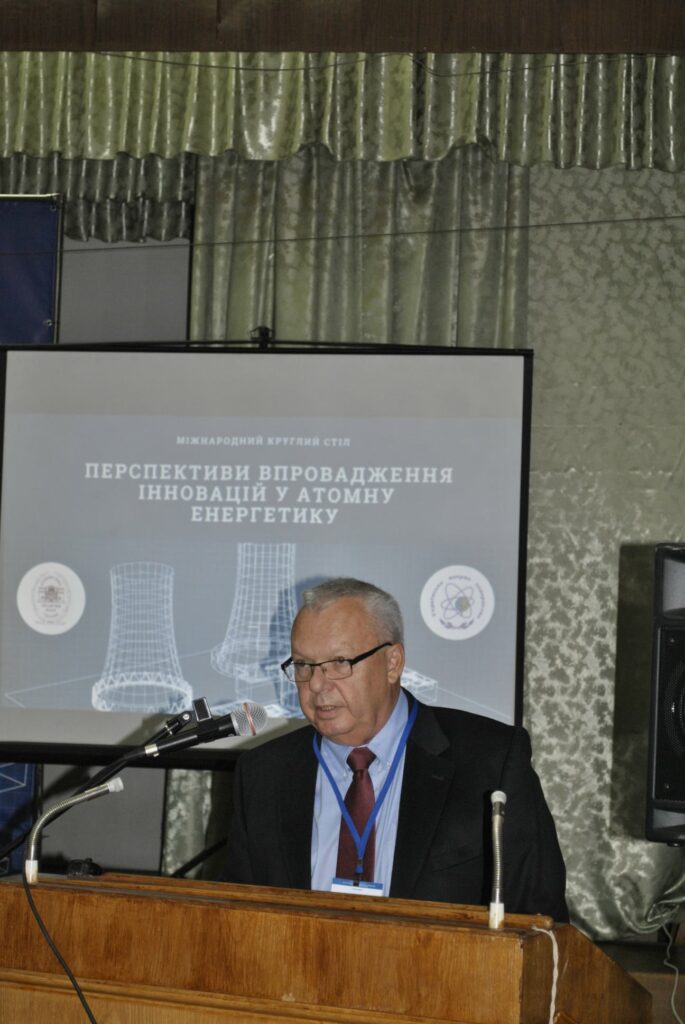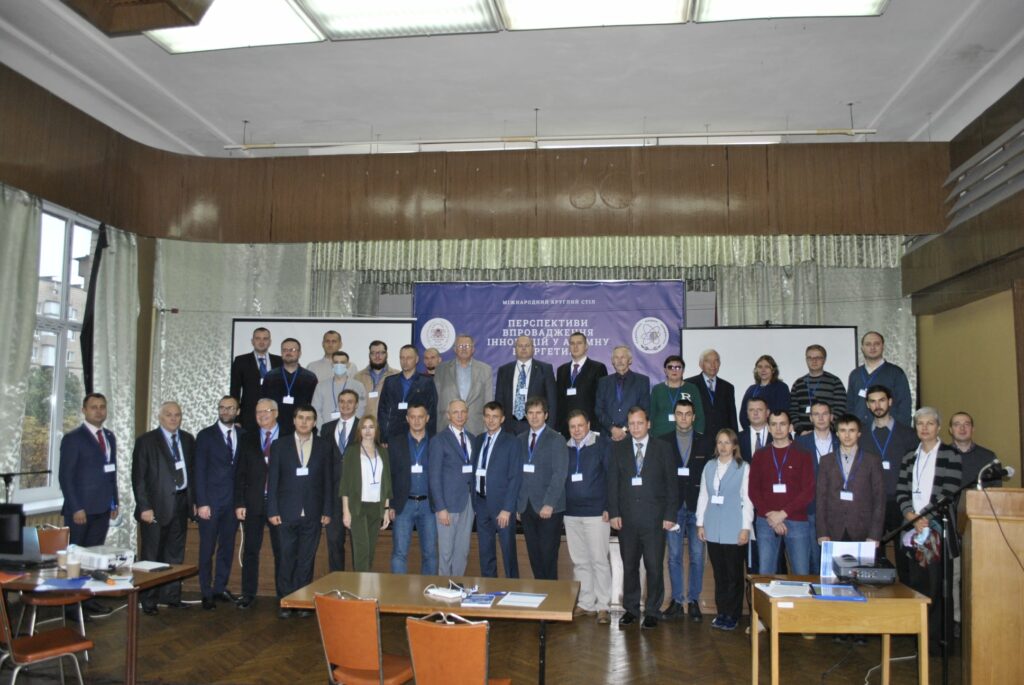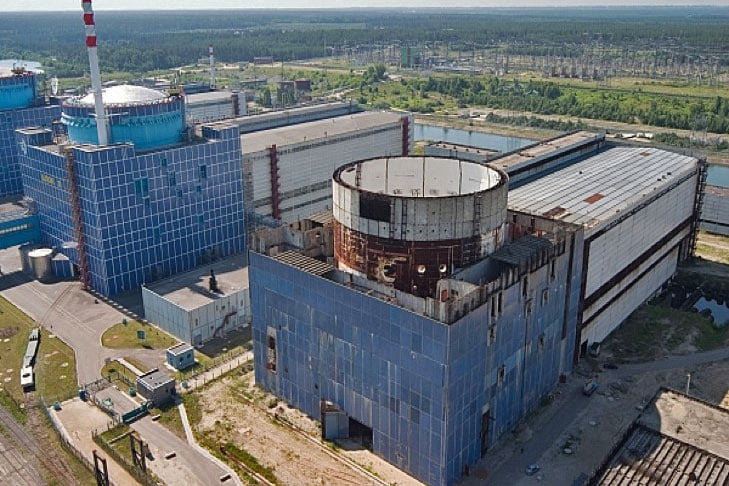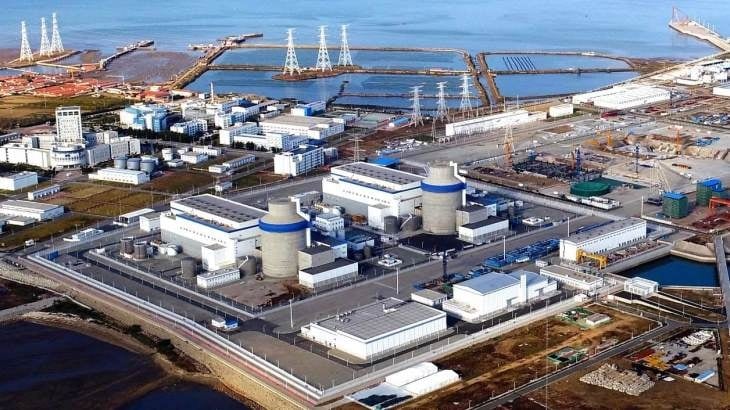What reactors shall we build in Ukraine, how does nuclear energy affect the country’s development and what can science offer the nuclear industry? Participants of the “Prospects for Innovation in Atomic Energy” round table organized by the Council of Young Scientists at the Department of Physical and Technical Problems of Energy of the National Academy of Sciences of Ukraine and the Ukrainian Nuclear Society with the support of the State Enterprise “National Nuclear Energy Generating Company “Energoatom” tried to answer these and other questions.
HISTORY OF THE ISSUE
In August 2021, during the visit of the President of Ukraine Volodymyr Zelensky to the United States, NNEGC Energoatom and the American company Westinghouse signed a Memorandum providing for the company’s participation in the completion of the Khmelnytsky nuclear power plant using AP1000 technology and the construction of four other Ukrainian power plants. This information continued to be heard.
As the Director of the Institute of NPP Safety Problems of the National Academy of Sciences of Ukraine Anatoliy Nosovsky reminded during the round table, the construction of the third and fourth power units of Khmelnytsky NPP under the WWER-1000 B-320 project began in 1985. In the 1990s, it was stopped by a moratorium on construction.

In 2010, the Agreement was ratified between Ukraine and Russia on construction of these power units, but with the WWER-1000 B-392Б reactor unit, which was proposed by Russian Atomstroyexport company. However, because of the annexation of Crimea and aggression in Donbass, the Agreement ceased to be in force. The next step in resolving the issue was to adjust the feasibility study in terms of changing the supplier of the reactor unit, and the Czech company Skoda was designated for this purpose. Now we have a fresh Memorandum. The parties agreed to use American technology, which is the only technology for Generation III + reactors licensed by the US Nuclear Regulatory Commission.
– It will be very problematic to complete the KhNPP power units, – Anatoliy Nosovsky thinks. – Building structures have not been preserved for 30 years, the premises on the minus levels are flooded with water, metal structures are in a terrible state. For these reasons, it would be advisable to demolish the old structures and build new modern power units on this site.

DIFFICULTIES OF THE CHOICE
Oleh Godun, Chief Engineer of the Scientific and Technical Center of NNEGC Energoatom, spoke in detail about the choice of the type of reactor unit for the construction of new NPP facilities in Ukraine. On the one hand, our specialists considered the power units of small modular projects, and on the other hand, in order to minimize possible construction costs, they considered units similar to those currently in operation in Ukraine.
For example, seven water-cooled water-moderated reactor projects were considered: from the Korean APR-1400 and the Chinese Hualong-1 on out to the American AP1000. The IAEA methodology was used for the comparative assessment. The methodology allowed the use of qualitative and quantitative criteria in such areas as economics, security and technological parameters.
– The integrated assessment, which was conducted in 2020 (before it became clear which technology we are inclined to), shows that AP1000 is first in line compared to other projects in terms of security, possible integration into our infrastructure, economic indicators, – Oleh Godun remarked.
In terms of capital construction costs, the Russian NPP-2006 project may compete with the American technology, but, firstly, what kind of cooperation can exist with the aggressor, and secondly, its price is not really clear.
– The latest information about the NPP-2006 dates back to 2013 when the cost of construction was about $ 4,700 per kilowatt of installed capacity, but it was the cost for Belarus, and in principle, it cannot be an objective indicator, – Oleh Godun said. – For AP1000, according to our information, this figure is 5 to 5.5 thousand dollars.
ECONOMIC EFFECT
Ukraine ranks third in the world in terms of the share of nuclear energy in the country’s overall energy balance. In this context, Danylo Lavrenov, Director of the Communication Department of SE NNEGC Energoatom, Executive Secretary of the Ukrainian Nuclear Society, noted that despite all the difficulties, we have now approached the moment when there are objective circumstances and reasons for further development of the nuclear industry and, in particular, construction of new units.
– If we look at the situation in the world, which is associated with global warming, the continuous increase in electric power consumption and the need to build new energy facilities, we will conclude that the choice of the technology to develop, is not so great, – he added.
Mr. Lavrenov also presented the results of the analytical study on the impact of nuclear energy on the development of Ukraine, conducted by the Ukrainian Nuclear Society. In particular, the impact on direct and indirect economic indicators: electricity production, number of jobs, volume of marketable products, taxes paid, gross domestic product (GDP), investment, labor costs, social security contributions, was assessed.
Thus, together with contractors of all levels, the nuclear industry paid 48 billion hryvnias (5.1% of the state budget revenues of Ukraine). Labor costs of those working in the industry amounted to UAH 49.1 billion. Net sales revenue is UAH 152 billion (this is 6.4% of Ukraine’s real GDP). In 2020, the nuclear industry provided about 136,000 jobs, which is an average of 0.9% of the total employed population of Ukraine.
Based on the methodology of the Organization for Economic Cooperation and Trade, the experts gave a forecast of jobs in the industry during the operation of existing power units and, potentially, after the construction of new ones.

– In total, one gigawatt of installed capacity creates about 50,000 jobs for the entire period – from construction to decommissioning and working with spent nuclear fuel and radioactive waste, – Oleh Godun said. – The two new power units will generate more than $ 14.5 billion in net revenue over their projected life and provide tax revenues of $ 5 billion. At the same time, the country’s GDP will increase by 40-60 billion dollars.
We should not forget about environmental indicators. One of the main advantages of nuclear energy is its carbon neutrality. According to the expert, Ukraine has very high indicators of the Sustainable Development Goals due to the fact that more than half of our energy balance belongs to the nuclear generation.
HYDROGEN OUTLOOK
There are more and more opinions in the world that in a few decades the world’s energy may completely switch to atom and hydrogen. By the way, last year the NNEGC Energoatom and NJSC Naftogaz signed a Memorandum aimed at studying the possibility of producing hydrogen from electric energy generated by nuclear power plants, as well as transporting this resource to the EU using gas infrastructure. So, it is not for nothing that several reports were devoted to the issues of hydrogen energy.
– In the future, if hydrogen displaces oil and gas, their niche in the market may be occupied by nuclear energy, because, in addition to electricity and heat, it will also generate fuel for cars, etc., – the Chairman of the Ukrainian Association of Energy Storage and Hydrogen Technologies Vasyl Doronin said. – In addition, nuclear energy can discharge excess production into the hybrid energy system, accumulating it in hydrogen.
Speaking about the prospects of industrial production of hydrogen using nuclear energy, the Director of Argus Service, Maksym Sagdiyev also suggested considering the possibility of “monetizing” the energy surplus of nuclear power plants into hydrogen, but with its transformation into ammonia, which is easy to transport.
OPTIONS TO INCREASE SAFETY
The issue of improving the safety of nuclear power plants has always become especially relevant after major accidents. According to Maksym Vyshemirsky, Head of the Emergency Documentation Laboratory at the State Scientific and Technical Center for Nuclear and Radiation Safety, after the accident at the Three Mile Island nuclear power plant in the United States, the requirements for training personnel and emergency documentation were significantly increased. The Chernobyl disaster has resulted in increased safety requirements for control systems and emergency protection systems. The last of the major accidents at the Fukushima nuclear power plant in Japan was no exception. It has resulted in increased safety requirements for stations in terms of protection from external impacts. This is reflected in the IAEA documents. According to Maksym Vyshemirsky, Ukraine also did not fall behind, but performed its stress tests. It turned out that we have certain gaps in the safety of nuclear power plants, and the results of the tests identified ways to overcome these gaps.
– There are two ways: the first one is the use of additional mobile technology, and the second one is introduction of stationary passive systems, – Mr. Vyshemirsky said. – The second option is more expensive. Therefore, Energoatom followed a faster and cheaper way of using mobile pumping units and diesel generators. At the same time, there are some nuances.
Emergency training shows that if emergency crew personnel are off-site, the success of such a strategy is jeopardized, as they have little time to raise personnel and activate the necessary equipment until a critical moment when fuel damage in the reactor core can occur.
Therefore, our scientists have considered other possible ways to overcome this problem. As a result, it is found that the most optimal for our nuclear power plants is a system of passive heat removal from the core. As Maksym Vyshemirsky noted, in this case, the only possible option would be to remove heat to the water in tanks, and, when boiling, it will expel heat to the atmosphere.
MATERIALS AND DEVICES
Modern concepts of design and construction of new generation nuclear reactors require the solution of a number of problems of radiation materials science.
According to Igor Kolodiy, a junior researcher at the Kharkiv Research Institute of Physics and Technology, this is, first of all, the development of materials capable to maintain high mechanical and corrosion properties, radiation resistance at high radiation doses and high temperatures (600 – 700 °C), which is necessary to achieve a higher degree of fuel burnout.
– Two types of steels are now considered as promising materials for new generation reactors: ferritic-martensitic and austenitic, – Mr. Kolodiy said. – The former has a relatively high radiation resistance, but low strength, and the latter – vice versa. The possible solution of the problem of increasing radiation resistance while maintaining high strength characteristics is the creation of dispersion-strengthened-by-oxides steels with a high density of emissions and their homogeneous distribution in the matrix.
The scientists have developed a technology for obtaining such material. Its ductility remains at a level sufficient for technological and operational purposes. It is promising for nuclear energy as a material for internal hull components and reactor shells.
Not all developments of our nuclear scientists are in demand in the country. But abroad they use their services. Andriy Sadovnikov, Head of the Department of Remote Systems and Technologies of the Institute of NPP Safety Problems of the National Academy of Sciences of Ukraine, presented innovative developments for AP 1000 reactors at the Haiyan NPP in China. By the way, as it is already mentioned above, we are going to build such reactors in Ukraine. The scientists-designers from the ISP proposed to remove the highly active sleeves from the reactor by twisting them into spirals. Work on the creation of the relevant device was carried out jointly with a Chinese company.
FOR EFFICIENCY … OF OIL PRODUCTION
It is possible to increase the efficiency of oil production with the help of nuclear reactors, – such opportunities were outlined by the Head of the Department of Nuclear Power Plants of the State University “Odessa Polytechnic” Volodymyr Kravchenko.
According to him, the decrease in oil production in Ukraine is caused by major fields depletion and their late stage of development. In such conditions, to increase efficiency, one can use the method of injecting a hot heat carrier agent into the oil-bearing seam in order to raise the oil temperature, reduce its viscosity and increase mobility. Today, steam generators are installed just near wells (in particular, in the United States), or, for example, a nuclear power plant is built to provide heat when extracting high-viscosity hydrocarbons (in Canada).
Our scientists have performed a feasibility study for using nuclear power plants to increase oil production as in the case of the Okhtyrka field in Sumy region. According to their estimates, the payback period of such a nuclear oil complex is 4.5 years.
FROM SEMICONDUCTORS TO MEDICINE
Energy is energy, but we should not forget about our research reactor, which operates at the capital’s Institute for Nuclear Research of the National Academy of Sciences. It can be used to solve many scientific problems. One of them is the effect of radiation on semiconductors. Yevhen Maly, a researcher and Chairman of the Council of Young Scientists of the Institute for Nuclear Research, spoke in detail about this work:
– We study the extent to which neutron irradiation changes the structure of semiconductors. If a semiconductor operates under normal conditions, it exhibits some properties. Under the effect of radiation, the properties may change. This feature must be taken into account when designing electronic equipment. The obtained results are useful when designing radiation-resistant optoelectronic modules, predicting the effects of powerful radiation fields on the communication lines and the means of control, in the military sphere.
Note that the scope of our research reactor is not limited to fundamental research. It becomes possible to solve a number of applied problems. It is at the Institute for Nuclear Research that, by irradiating the samples, we can find how long it is possible to operate the reactor vessel.
– According to the results of our scientists’ assessment, the decommissioning of 11 out of 15 operating power units has been postponed for 10 to 20 years, – NAS President Anatoliy Zagorodniy said during the jubilee session of the Academy’s General Meeting. – The economic effect of extending the life of one unit is about 1.5 billion hryvnias per year.
Besides, with the help of the research rector one can get radionuclides that are used in medicine, industry, and even in jewelry. For example, in order to increase the jewelry value of topazes, they are irradiated with neutrons.
WHAT TO DO WITH THE “LEGACY”?
Today, reliable isolation of spent nuclear fuel and high active wastes from human living environment for thousands of years is a challenge. The issue of the “legacy” of nuclear energy was reflected in the reports of the round table participants.
According to the IAEA concept, the solution is to isolate such wastes in geological formations in special tanks, which must remain tight for a period sufficient for the decay of radionuclides and bringing them to background readings. The speech by the junior researcher at the National Research Center “Kharkiv Institute of Physics and Technology” Kostiantyn Lobach was dedicated to this issue.
There is no a unique approach in the world to technologies and materials for geological disposal of high active radioactive waste. But the key requirements for container materials are well known: it is corrosion and radiation resistance.
– On the basis of the comprehensive research carried out in world research centers, it is proposed to use ceramic materials (SiC – silicon carbide) or ceramic protective layers (for example, TiO2 and CrN) as a material for containers for high active wastes and spent nuclear fuel. – Kostiantyn Lobach said. – High melting point (2730 ° C), radiation and corrosion resistance, and lightness are among the advantages of SiC materials.
Our scientists have studied the effect of gamma radiation on the strength and structure of SiC ceramics with the addition of chromium. Appropriate ceramic samples were made in NSC KhPhTI. The result of the study proves the possibility to use this composite as a material of containers for storage and geological disposal of high active wastes and spent nuclear fuel.
The obtained results formed the basis of the international project “ConCorD” (Container Corrosion under Disposal conditions) under the EU program for radioactive waste management EURAD.
In addition to solids, tens of thousands of cubic meters of liquid radioactive wastes are currently accumulated in Ukraine; they are stored in temporary storage facilities, which is a significant environmental safety problem.
Kostiantyn Yaroshenko, a researcher at the State Institution “Institute of Environmental Geochemistry of the National Academy of Sciences of Ukraine”, presented the results of the study of the clay sorbents and zeolites efficiency in the sorption of radionuclides from radiation-contaminated waters of NPPs equipped with WWER reactors. In particular, scientists have found that the combination of sorption and ozonation processes allows more efficient removal of radionuclides from the model solution of drain waters.
As Konstiantyn Yaroshenko summed up, cheap and affordable sorbents (bentonite and zeolite) modified with simple reagents are really effective and can be used to remove radionuclides from drained waters of nuclear power plants. Therefore, the results of the work promote further development of the basic technological scheme and transformation of liquid wastes into the state of their suitability for long-term storage and disposal.

UPDATE THE ENERGY STRATEGY
Recognize the development of nuclear energy as a priority for Ukraine and ensure that the share of nuclear energy in total energy balances remains above 50% by 2050. Such a proposal to the authorities is written in the Resolution approved on the results of the round table.
The participants of the meeting also propose to include in the renewed energy strategy of Ukraine, the issue of construction of new NPP power units with evolutionary reactors with increased requirements for safety and economic attractiveness.
In order to avoid delays in the construction of new power units, it is proposed to amend Article 20 of the Law of Ukraine “On the Use of Nuclear Energy and Radiation Safety” and determine a single local authority that approves location of nuclear facilities and enterprises on the territory.
In addition, the proposals include the development of a state target program for the development of nuclear science, technology and preservation of scientific and human resources, stimulation of technical training improvement in higher education institutions by improving material support and implementing dual education mechanisms, as well as promotion of further research on the hybrid energy system development in Ukraine based on nuclear generation and renewable energy sources.
By the way
THE USE OF ATOMIC ENERGY WILL DOUBLE BY 2050
The International Atomic Energy Agency expects that the use of nuclear energy in the world will double by 2050. For the first time in ten years since the accident at Japan’s Fukushima nuclear power plant, the IAEA has revised its forecasts for potential growth of nuclear power capacity. This was reported by the NNEGC Energoatom.
– New forecasts show that nuclear energy will continue to play an indispensable role in the production of low-carbon energy. – IAEA Director General Rafael Mariano Grossi said. – We are increasingly aware that nuclear power, which does not emit CO2 during operation, is vital in our efforts to achieve zero emissions.
According to the scenario of the new forecast, the IAEA expects that the world’s nuclear capacity will double to 792 GW by 2050 from 393 GW (as of last year). But its implementation will require serious actions, in particular, the accelerated implementation of innovative nuclear technologies.
The materials are prepared by Dmytro SHULIKIN
Svit newspaper, № 41- 42, November 2021
